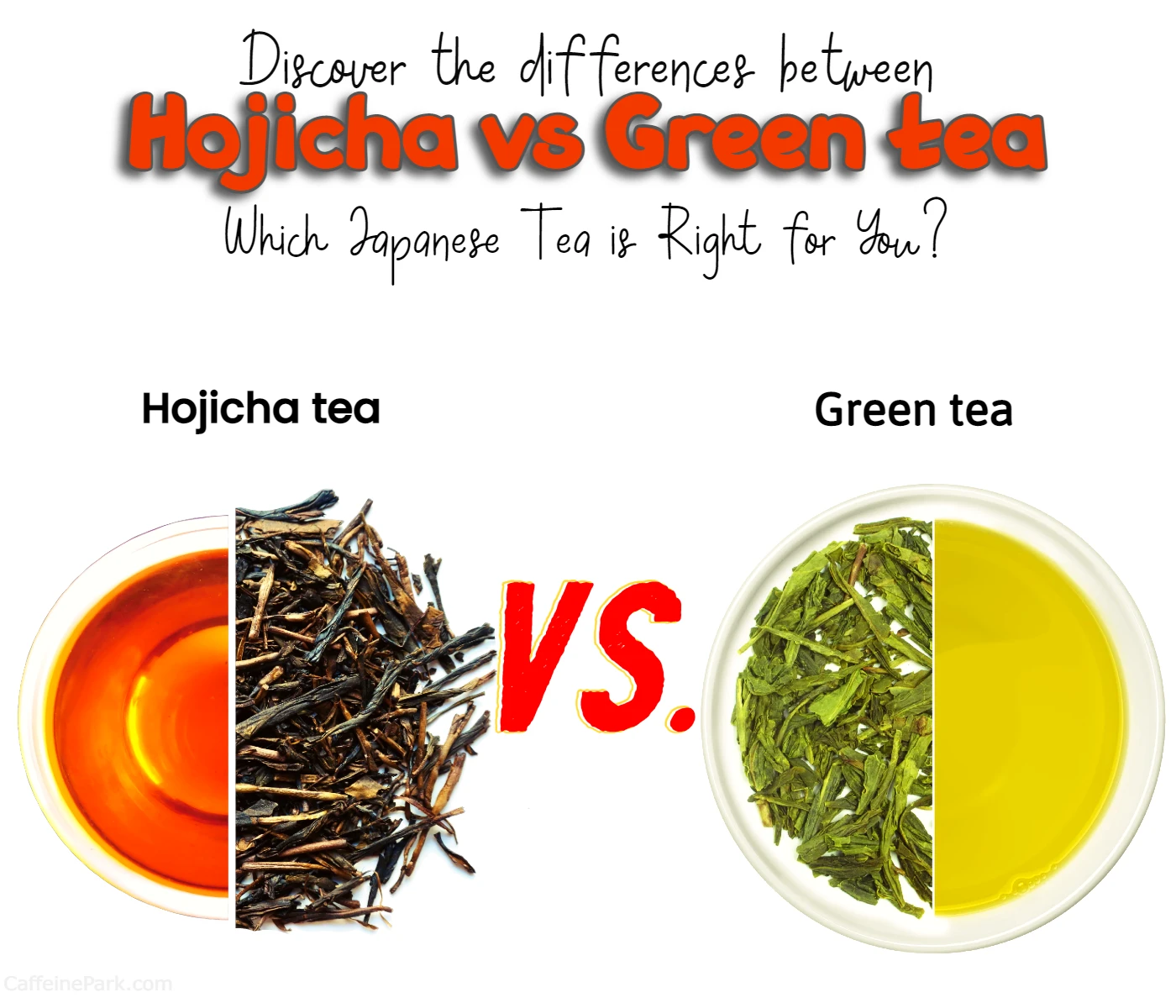Hojicha vs Green tea

Welcome to my blog on the differences between Hojicha and Green tea! If you’re a tea lover, chances are you’ve heard of these two popular Japanese teas. While they may look similar, they offer distinct flavors and health benefits that set them apart. Whether you’re a green tea enthusiast or a curious newcomer, this blog will help you understand the differences between Hojicha and Green tea and decide which one is right for you.
First, let’s talk about Green tea. It’s made of steaming tea leaves, which gives it a fresh, grassy taste and a higher caffeine content. Green tea is known for its health benefits, including its ability to boost metabolism, reduce the risk of cancer and type 2 diabetes, and promote heart health. It’s also rich in antioxidants, which can help protect your body against damage from free radicals.
Now, let’s move on to Hojicha. This tea is made by roasting tea leaves, which gives it a nutty, toasty flavor and a lower caffeine content. Hojicha is known to aid in digestion, promote relaxation, and reduce inflammation. It’s a great choice for those who are sensitive to caffeine or prefer a more mellow flavor. Plus, like Green tea, Hojicha is also rich in antioxidants.
Are you curious to learn more about Hojicha and Green tea? Then keep reading! I’ll dive deeper into the differences between these two teas, including their unique flavors, caffeine content, and health benefits. By the end of this blog, you’ll be able to make an informed decision on which tea is right for you. So, grab a cup of your favorite tea, and let’s get started!
Here’s a quick chart outlining the differences between Hojicha and Green tea:
| Hojicha | Green tea | |
|---|---|---|
| Flavor | Nutty, toasty | Fresh, grassy |
| Caffeine content | Lower | Higher |
| Production method | Roasted | Steamed |
| Health benefits | Aids in digestion promote relaxation, reduce inflammation | Boosts metabolism, reduces the risk of cancer and type 2 diabetes, promotes heart health |
| Antioxidants | Yes | Yes |
Difference between Green tea and Hojicha
What is Green tea?
Green tea is a type of tea that is made from unfermented tea leaves. The leaves are picked, steamed or pan-fried, and then rolled and dried. The process of steaming or pan-frying the leaves helps to preserve the natural flavor and nutrients of the tea. Green tea is known for its fresh, grassy, and slightly bitter taste.
Green tea has been consumed in Japan for centuries and is an important part of Japanese culture. It is commonly served at traditional tea ceremonies and is enjoyed throughout the day. Green tea is also a popular ingredient in Japanese cuisine and is used to flavor everything from sweets to savory dishes.
What is Hojicha?
Hojicha is a type of Japanese green tea that is roasted. Unlike traditional green tea, Hojicha is made from roasted tea leaves rather than steamed or pan-fried leaves. The roasting process gives Hojicha a distinctive nutty, toasty flavor and a reddish-brown color.
Hojicha was first developed in Kyoto, Japan in the 1920s. It was originally made from low-quality tea leaves that were unsuitable for other types of tea. The roasting process helped to mask the lower quality of the leaves and created a unique flavor. Today, Hojicha is made from higher-quality tea leaves and is enjoyed for its unique taste and aroma.
Flavor Comparison: Green tea vs Hojicha
Green tea and Hojicha have very different flavors. Green tea has a fresh, grassy taste with a slightly bitter finish. Hojicha, on the other hand, has a nutty, toasty flavor with a milder taste and no bitterness.
The difference in flavor between the two teas can be attributed to the roasting process that Hojicha undergoes. Roasting the tea leaves changes the chemical composition of the tea, resulting in a different taste and aroma.
Caffeine Content: Green tea vs Hojicha
Green tea and Hojicha also differ in their caffeine content. Green tea is known for its high caffeine content, with an average of 35mg per cup. Hojicha, on the other hand, has a lower caffeine content, with an average of 7mg per cup.
The roasting process that Hojicha undergoes helps to break down the caffeine in the tea leaves, resulting in a lower caffeine content. This makes Hojicha a good choice for those who are sensitive to caffeine or who want to limit their caffeine intake.
Brewing Methods: Green tea vs Hojicha
Green tea and Hojicha require different brewing methods due to their different processing methods and flavor profiles.
To brew green tea, you should use water that is around 175-185°F (80-85°C) and steep the tea for 1-2 minutes. The exact steeping time and temperature will depend on the type of green tea you are using, so it’s important to follow the brewing instructions for the specific type of tea you have.
Hojicha, on the other hand, can be brewed using water that is around 200-212°F (93-100°C) and steeped for 1-2 minutes. The higher water temperature and longer steeping time help to bring out the nutty, toasty flavors of the tea.
Health Benefits: Green tea vs Hojicha
Green tea and Hojicha are both known for
their health benefits. Both teas contain antioxidants and other beneficial compounds that can promote good health. Here are some of the health benefits of green tea and Hojicha:
Health Benefits of Green Tea
- Boosts metabolism: Green tea is known to boost metabolism, which can help with weight loss and weight management.
- May reduce the risk of cancer: Green tea contains antioxidants that can help to reduce the risk of certain types of cancer, such as breast, prostate, and colorectal cancer.
- Promotes heart health: Green tea has been shown to help reduce LDL (bad) cholesterol levels and blood pressure, which can help to promote heart health.
- Helps with mental alertness: Green tea contains caffeine, which can help to increase mental alertness and focus.
- May reduce the risk of type 2 diabetes: Green tea has been shown to help regulate blood sugar levels and improve insulin sensitivity, which can help to reduce the risk of type 2 diabetes.
Health Benefits of Hojicha
- Lowers caffeine content: As mentioned earlier, Hojicha has a lower caffeine content than green tea, making it a good choice for those who want to limit their caffeine intake.
- Contains antioxidants: Hojicha still contains antioxidants, despite the roasting process. These antioxidants can help to reduce oxidative stress and promote good health.
- May aid in digestion: Hojicha has been traditionally used in Japan to aid in digestion and improve gut health.
- Promotes relaxation: The lower caffeine content of Hojicha and its nutty, toasty flavor can help to promote relaxation and reduce stress.
- May help to reduce inflammation: Some studies have suggested that the antioxidants in Hojicha may help to reduce inflammation in the body, which can help to prevent chronic diseases.
Which is Better: Green tea or Hojicha?
Both green tea and Hojicha have their own unique flavors and health benefits, so it’s difficult to say which is better. It really comes down to personal preference and what you’re looking for in a tea.
If you’re looking for a tea with a fresh, grassy taste and a high caffeine content, then green tea might be the better choice for you. On the other hand, if you prefer a tea with a nutty, toasty flavor and a lower caffeine content, then Hojicha might be the way to go.
It’s worth noting that green tea and Hojicha can also be enjoyed together as part of a tea blend. Some tea companies offer blends that combine green tea and Hojicha for a unique flavor and health benefits.
Final Thoughts
Green tea and Hojicha are two distinct Japanese teas with different flavors, caffeine content, and health benefits. Both teas are made from the same tea plant, but the processing methods used for each tea result in unique flavors and characteristics.
Whether you prefer the fresh, grassy taste of green tea or the nutty, toasty flavor of Hojicha, both teas offer a range of health benefits and can be enjoyed at any time of day. So why not give both a try and see which one you like best?
Alternative to Green tea and Hojicha
If you’re looking for an alternative to Green tea and Hojicha, there are many other types of tea that you can try. Here are a few options:
- Black tea: Made from the same plant as Green tea and Hojicha, black tea is fully oxidized and has a bold, robust flavor. It contains more caffeine than Green tea and Hojicha, making it a great choice for a morning pick-me-up.
- White tea: This tea is made from the youngest leaves and buds of the tea plant and is the least processed type of tea. It has a delicate, floral flavor and contains less caffeine than Green tea and Hojicha.
- Oolong tea: This tea is semi-oxidized and falls somewhere between Green tea and Black tea in terms of flavor and caffeine content. It has a fruity, floral taste and is often described as having a “sweet aftertaste.”
- Herbal tea: Unlike Green tea and Hojicha, which are made from the tea plant, herbal teas are made from a variety of herbs, spices, and flowers. They are naturally caffeine-free and come in a wide range of flavors and health benefits.
- Matcha: This Japanese tea is made from finely ground Green tea leaves and has a vibrant, grassy flavor. It’s higher in caffeine than Green tea but lower than Black tea and is often used in traditional tea ceremonies.
So, if you’re looking for a change from Green tea and Hojicha, give one of these teas a try!
FAQs
Hojicha and green tea are two different Japanese teas that are made from the same tea plant. The main difference between the two is that Hojicha is roasted, giving it a nutty, toasty flavor and a lower caffeine content, while green tea is steamed, giving it a fresh, grassy taste and a higher caffeine content.
Both Hojicha and green tea offer health benefits, including antioxidants and other beneficial compounds. Green tea is known to boost metabolism, reduce the risk of cancer and type 2 diabetes, and promote heart health. Hojicha, on the other hand, is lower in caffeine and can aid in digestion, promote relaxation, and reduce inflammation. Ultimately, which tea is better for your health depends on your individual health needs and preferences.
Yes, Hojicha and green tea can be blended together to create a unique flavor and health benefits. Some tea companies offer blends that combine Hojicha and green tea for a balanced taste and health benefits.
To brew Hojicha, use boiling water and steep for 30-60 seconds. To brew green tea, use water that is around 175°F and steep for 1-2 minutes. Adjust the steeping time and water temperature to your taste preference.
Yes, both Hojicha and green tea can be enjoyed daily as part of a healthy diet. However, it’s important to note that both teas contain caffeine, so it’s recommended to limit consumption to moderate amounts to avoid adverse effects.
Read More:





